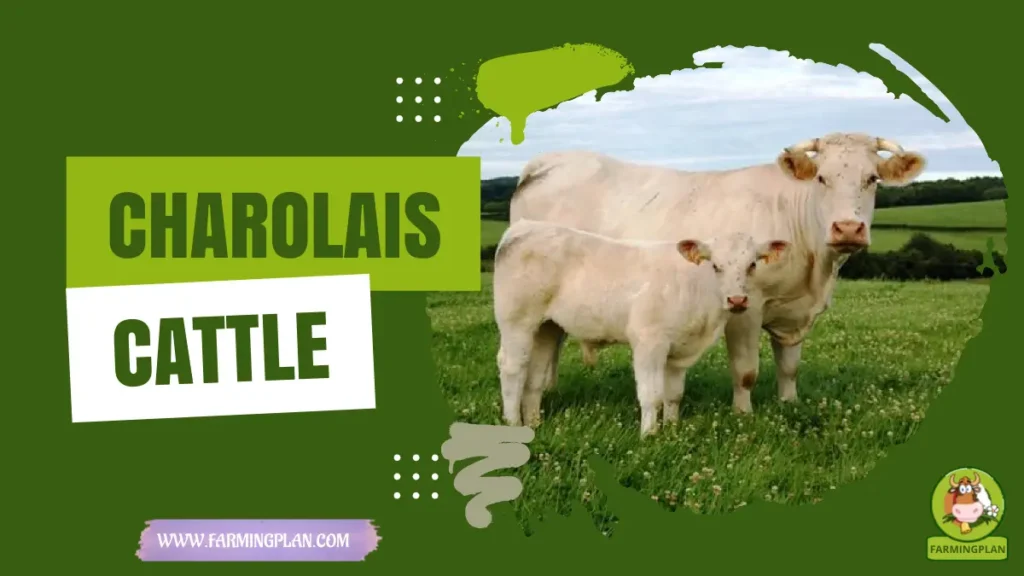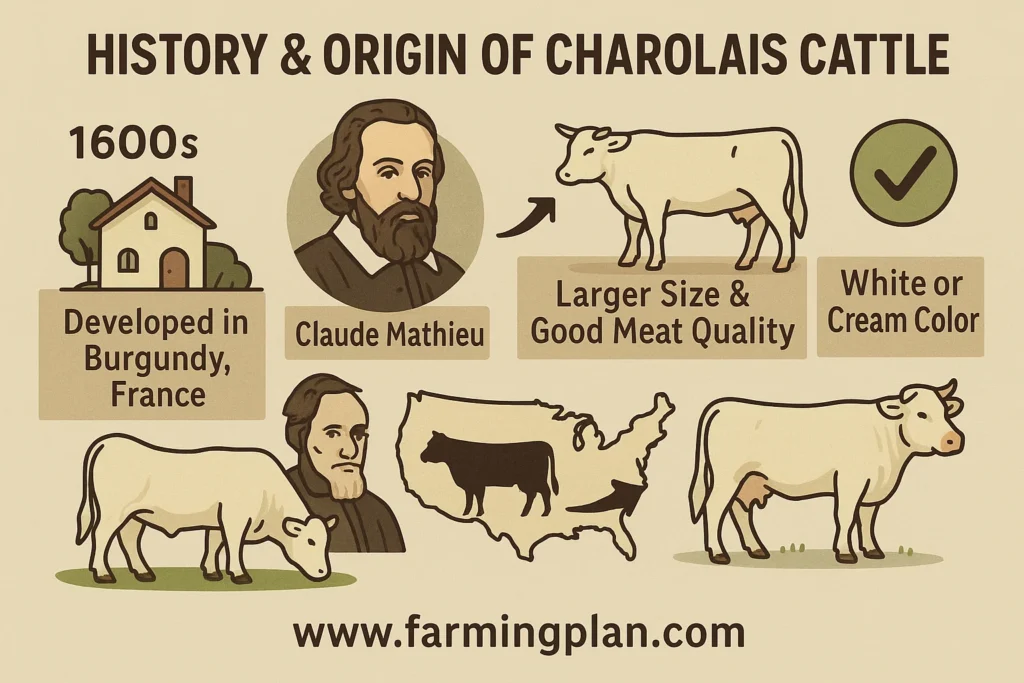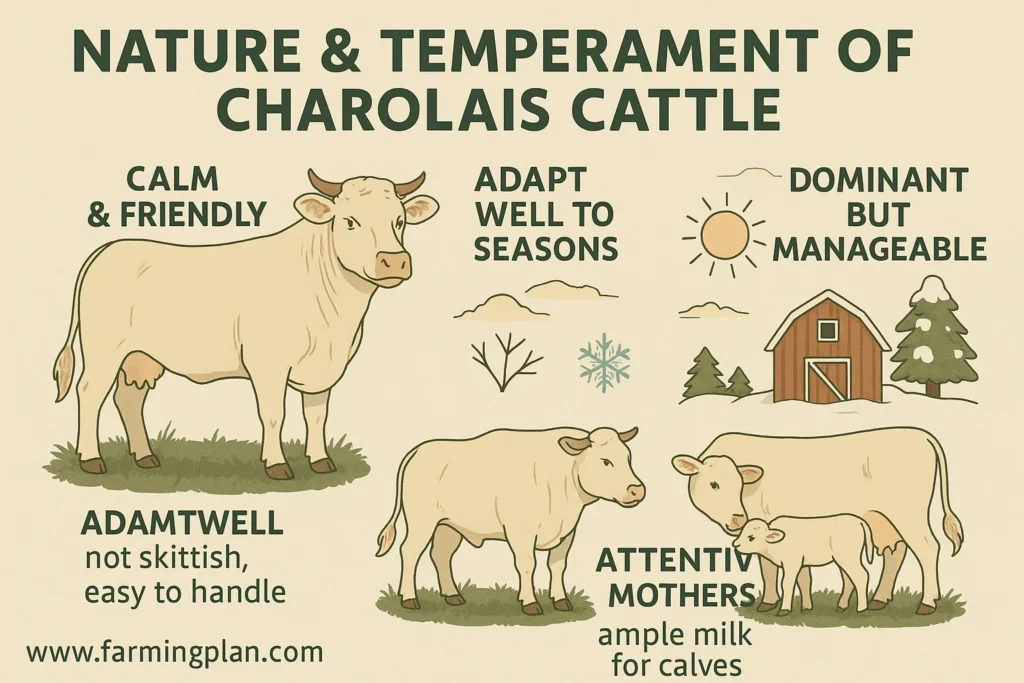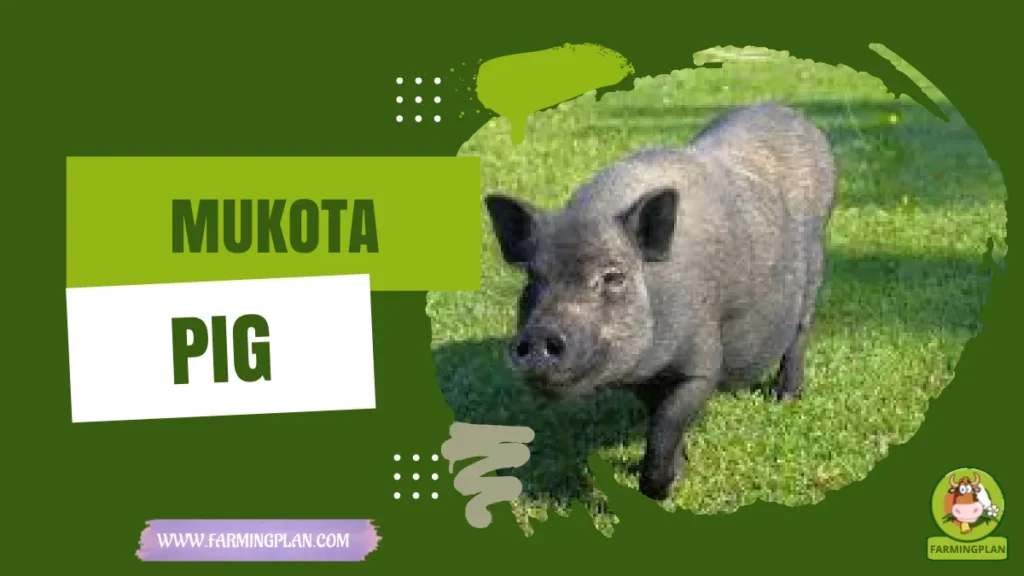If you’re interested in beef cattle that grow fast and pack serious muscle, Charolais Cattle are a top choice. I’ve worked with this impressive white breed for years, and they’re not only big and strong but also hardy and reliable. Originating in France and now popular across the United States, Charolais cattle are loved by farmers for their size, strength, and quality beef. Whether you’re a seasoned breeder or new to cattle farming, I’ll guide you through everything—from finding charolais cattle for sale to caring for them and understanding what makes this breed so special.

History & Origin of Charolais Cattle
In the 1600s, animals in Burgundy were introduced as white Charolais Cattle, as farmers bred them in an effort to improve cattle size and meat quality. It was Claude Mathieu, who strongly affected the difference and characteristics found in the Leonberger breed now. After some years, Saga cattle were known for helping French beef producers due to their speed of growth and weight.

The breed’s traits were adopted globally, with American Charolais coming from French imports and improved by breeders. Because the herd book recorded all registrations, breeders needed to maintain strong standards for the breed. Their unique color, cream or white, is the main thing that distinguishes Charolais, hence the names “white breed” and “Charolaise cattle.” They attract attention with their appearance and for helping to improve beef cattle genes everywhere.
Read More: Angus Cattle: A Scottish Breed of Cattle
Characteristics of Charolais Cattle
When you look at Charolais cattle, you immediately notice their impressive size. Mature bulls can weigh over 2,000 pounds, while cows and heifers are no lightweight either. Their cream-colored coat is sleek and short, helping them handle both hot summers and cold winters. This adaptability, I’ve seen them thrive on lush summer meadows as well as in harsher winter pastures, is a testament to their hearty build.

Besides their size, Charolais cattle are known for their rapid growth rates. Calves put on weight quickly, which is a big plus if you’re raising cattle for meat production. This rapid growth not only ensures early market readiness but also makes them excellent draft animals too, though most farmers keep them primarily for beef. The breed also features strong legs and hooves, which means they handle different terrains well—another reason they’re so popular among cattle producers.
Read More: Lowline Cattle: Best Small-Farm Breed
Nature & Temperament of Charolais Cattle
One thing I appreciate about Charolais cattle is their calm and friendly nature. They aren’t the skittish type you’d worry about when moving them around or during breeding. This temperament, which makes them suitable for both small hobby farms and large commercial operations, means you can handle them safely without stressing either yourself or the animals.

They adapt well to seasonal changes, comfortably grazing on summer pastures and staying content during winter months with proper shelter and feed. The bulls are dominant but manageable, and the cows are attentive mothers, producing enough milk to keep their calves healthy and growing. For new farmers, that ease of handling is a real bonus.
Read More: Highland Cattle: Discover These Gentle Giants
Food & Diet
Feeding Charolais cattle well is key to unlocking their rapid growth and beef quality. They thrive on high-quality forage, especially during the summer when lush pastures give them plenty of nutrients. I always recommend rotating grazing areas to keep the grass fresh and prevent overgrazing. For winter, make sure to provide enough hay and supplemental feed to maintain their weight and health.
Calves, especially first-calf heifers, need a steady flow of milk from their mothers, so good nutrition for the cows is critical. Avoid sudden changes in diet to prevent digestive issues. I’ve learned that balanced mineral supplements help keep these cattle healthy, supporting everything from hoof strength to immune system function. Proper feeding doesn’t just keep them alive; it keeps them thriving.
Usage/Purpose
Charolais cattle are primarily raised for meat production, and they excel at it. Their rapid weight gain and heavy carcass make them favorites in the beef industry. But that’s not all—they’ve also been used as draft animals historically because of their sturdy build and power. Nowadays, most farmers focus on their beef quality, but some breeders still appreciate their versatility for work and show purposes.
Crossbreeding Charolais with other beef breeds like Devon can improve calf size and meat quality, which is why many breeders keep Charolais bulls for stud. If you’re hunting for charolais cattle for sale, keep in mind their strong market demand means it’s best to buy from reputable breeders who maintain pure bloodlines.
Special Features
One of the breed’s standout features is their rapid growth rate. Compared to other beef cattle breeds, Charolais calves gain weight faster, leading to earlier market readiness. They also boast heavier mature weights and are generally more tick-resistant than some red cattle breeds. Breeding efficiency is another major plus—selective breeding over centuries has refined their genetics to produce strong, healthy calves with excellent meat quality. Some rare crosses result in unique colors, like blue-gray shades, but the classic cream-colored Charolais remains the most popular and recognizable.
Health Issues & Prevention
Charolais cattle are hardy but not immune to common cattle diseases. Respiratory infections and foot rot can pop up if you’re not vigilant. Watching for symptoms like coughing, nasal discharge, or limping is crucial. Vaccinations and parasite control programs form the backbone of prevention. Good hygiene and proper shelter during winter help reduce stress-related illnesses. I’ve found that regular health checks and a clean environment go a long way in keeping the herd healthy. Early detection and prompt treatment make all the difference when managing a cattle operation.
Great Herds Start With Strong Genetics—Choose Charolais For Power, Growth, And Reliability!
Step-by-Step Farming Guide / Pet Owner Care Guide
This Step-by-Step Farming Guide walks you through everything you need to raise and care for Charolais cattle successfully. Whether you’re a beginner or experienced farmer, you’ll find practical tips and clear instructions to keep your herd healthy, happy, and thriving.
Step 1: Choosing Your Charolais Cattle
Start by finding reputable Charolais breeders offering bred Charolais cows for sale. Look for healthy animals registered in the herd book to ensure strong genetics. Avoid buying from unverified sources because quality counts when building your herd.
Step 2: Preparing Pasture and Shelter
Set up ample pasture space with nutrient-rich grass for your cattle to graze during warmer months. Ensure you have a sturdy shelter to protect them during cold winters. Good drainage and clean water access are essential.
Step 3: Feeding and Nutrition
Feed your cattle high-quality forage and consider supplemental grain during winter or when pasture is sparse. Monitor the diet closely for first-calf heifers and growing calves to support healthy development.
Step 4: Daily Care and Monitoring
Check your cattle daily for signs of illness or injury. Keep water troughs clean and provide mineral supplements. Pay attention to the bulls and cows’ behavior, especially during breeding seasons.
Step 5: Breeding and Calf Management
Manage breeding cycles by selecting bulls with desirable traits from the herd book. Observe cows closely around calving time and assist if needed. Ensure calves receive colostrum early for immunity and monitor their growth carefully.
Step 6: Seasonal Adjustments
Adapt your care routines with the seasons—offer shade and plenty of water in summer, and increase feed and bedding in winter. Rotate pastures to maintain healthy grass and prevent parasites.
Expert Tips & Best Practices
Make it a habit to pick bulls from the herd book’s list of proven Charolais ancestors when expanding your herd. By using this practice, your calves benefit from strong genetics and are expected to be healthier and more productive. Sticking to well-documented bulls in your breeding program helps you maintain the same high standards.
Shifting the location where the animals graze is important for keeping your pastures in good shape. Regularly moving your cattle stops them from overgrazing, encourages new growth of grass and saves your soil. Cattle fed from nutritious pastures are likely to grow and feel better. Recording when each cattle cycle, its well-being and every treatment helps improve herd management. Using these records, you are able to see your cattle’s development, prepare wise decisions and notice any issues that keep repeating. When information is organised, it’s helpful for choosing pets and for visiting the veterinarian.
Always be on the lookout for early symptoms of disease in your farm animals. Separating sick pets right away helps to halt the spread of sickness and increases the chance of a good recovery. When the problem is spotted early, lives are saved and financial costs are dramatically less. In addition, selective breeding helps increase traits like weight in calves and the volume of milk produced. Selecting suitable animals to breed helps you make your herd more steady and fit, so they can meet both your expectations and the needs of your farm.
FAQ
What is the average weight of a Charolais bull?
Mature Charolais bulls typically weigh between 2,000 and 2,500 pounds, making them one of the heaviest beef breeds.
How fast do Charolais calves grow?
Charolais calves gain weight rapidly, often reaching market size faster than many other breeds due to their efficient growth rate.
Are Charolais cattle good for small farms?
Yes, their calm temperament and adaptability make Charolais suitable for both small farms and large commercial operations.
What makes Charolais beef cattle unique?
Their rapid growth, heavy muscle build, and creamy white coat distinguish Charolais as a top beef-producing breed worldwide.
Where can I find Charolais cattle for sale?
Look for reputable breeders registered in the Charolais herd book; many have websites or listings through cattle associations.
Conclusion
Anyone interested in cattle or beef production will find raising Charolais cattle to be very fulfilling. The white cattle we see now first appeared in seventeenth-century France and became a popular and efficient breed known around the world. Calm character, fast development and a sturdy body are the reasons breeders and farmers like them. You will find great value in Charolais cows, whether you want them for your herd or to sell as bred cows. Proper feeding, training and breeding choices allow your herd to perform well all year.


